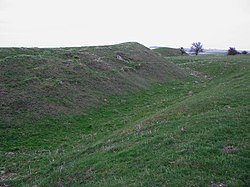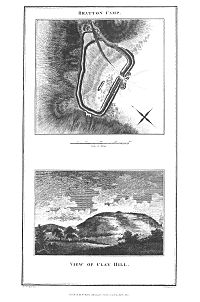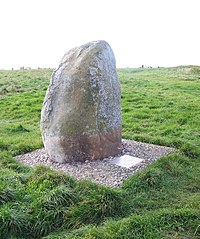Bratton Camp
| Bratton Camp | |
|
Wiltshire | |
|---|---|
 Earthworks at Bratton Castle | |
| Type: | Hill fort |
| Location | |
| Location: | 51°15’49"N, 2°8’37"W |
| History | |
| Built Bronze Age, Iron Age | |
| Information | |
| Owned by: | English Heritage |
| Website: | Bratton Camp and White Horse |
Bratton Castle, also known as Bratton Camp, is a bivallate Iron Age hill fort on Bratton Down, at the western edge of the Salisbury Plain escarpment. The hill fort comprises two circuits of ditch and bank which together enclose a pentagonal area of 23 acres.
The Westbury White Horse, a hill figure first documented in 1742, lies on the west side of the hill fort.[1]
Description

The short west side and the long north side occupy the crest of steep escarpment slopes and the ditches are stepped one above the other, the rampart slopes rising 16 feet and 20 feet above the base of the ditches. The defences here span a total width of 100 feet.
The south side of the hill fort and the southern half of the east side cross Bratton Down and here the twin ramparts are of roughly equal height and 100 feet in width. The northern half of the east side crosses the head of a re-entrant valley where the outer rampart and ditch have been largely destroyed by quarrying or landslips and the construction of a farm track. The short north east side straddles a narrow steep-sided ridge up which runs the Port Way. This passes through a possible original entrance, at which point the two ramparts have separated to form a small annexe, the outer ditch of which has, in places, been removed by quarrying. Quarrying has, in the past, also taken place within parts of the interior of the fort.[1]
Archaeology
The hill fort was one of the sites excavated by Jeffery Whittaker prior to 1775, which is thought to have been one of the earliest archaeological excavations to have taken place in Wiltshire. The excavation was poorly documented but it is believed that Roman and Saxon coins were found within the vicinity of the fort.[1] Later excavations were carried out by William Cunnington and Sir Richard Colt Hoare. Notably three barrows within and around the castle were excavated and recorded
Bratton G1
A Long Barrow, within which was found two primary cremations on a platform with a pile of pebble stones and one chalk bead covered with 'vegetable earth', intermixed with pottery and animal bones at four and five feet deep. Three secondary inhumations were found near the top.[2]
Bratton G2
A Bowl barrow containing two cremation urns, the one placed within the other, and an interment of burnt bones. The large urn was broken in pieces; the small one, containing about three pints was better preserved and is contained within the Wiltshire Heritage Museum. It is described as particular in its shape, having a perforated and projecting handle.[2]
Bratton G8a
A small round barrow less than one foot high, contained a circular cist with a crouched skeleton, but no relics. The skull is at Cambridge Museum.[2]

Location
The site is located to the southwest of the village and parish of Bratton in Wiltshire. The hill has a summit of 740 feet above sea level. The site and surrounding downs are easily accessible by public footpath.
See also
Outside links
| ("Wikimedia Commons" has material about Castle Bratton Camp) |
- Map: ST90125164
- National Monuments Record: No. 211829 – Bratton Castle
References
- ↑ 1.0 1.1 1.2 National Monuments Record: No. 211829 – Bratton Castle
- ↑ 2.0 2.1 2.2 G1 "Wiltshire Heritage Museum: Bratton G1". http://www.wiltshireheritagecollections.org.uk/wiltshirestourheadsites.asp?page=place&filename=stheadpl.mdf&itemId=Bratton G1. Retrieved 7 March 2011. Cite error: Invalid
<ref>tag; name "Wilt" defined multiple times with different content
